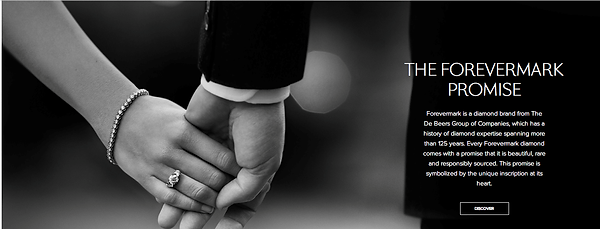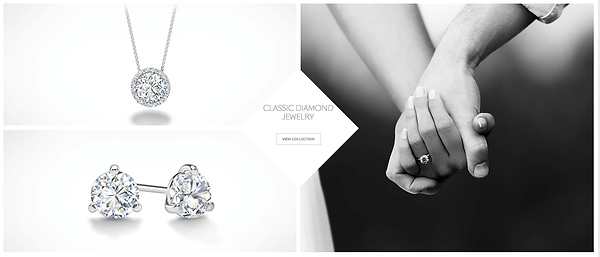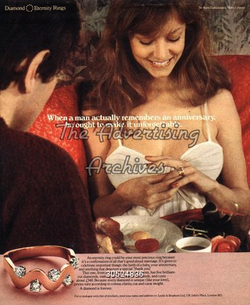
Diamonds
Worth Pennies or Millions?

De Beers is Forever
Popularity of Diamond Engagement Ring
Depending on material, shape, and setting, the De Beers engagement ring can vary from as low as $1,400 to as high as $25, 500. Similar to various other commodity chains, workers at the end of the commodity chain (ie retail sellers, CEOs) tend to receive the highest salaries. In fact, although mine workers may have the longest days from 8am to 5pm, miners often only receive about $2 per day (“Rich Man”, 2004). In contrast, a sales associate at a De Beers boutique may earn about $18.50 per hour (“Cartier Salaries”, 2014). Undoubtedly, managers earn a much higher salary and salary continues to increase as a worker climbs up the retail ladder.
The diamond ring has become a symbol for marriage engagement around the globe. However, the popularity of the diamond ring may vary among countries. In the US for example, 80- 85% of women received a diamond engagement ring, and about 85% of women owned some form of diamond jewelry (Spektorov, et al., 2012). In contrast, only about 40%, 60%, and 40% of women in China, India, and Russia respectively, owned at least one item of diamond
Popularity of receiving a diamond engagement ring still remains mostly popular in the US and UK although popularity is rapidly increasing in China, India, and Russia.
jewelry (Spektorov, et al., 2012). In these developing nations, it is often more common for the more affluent classes to own diamond jewelry (Spektorov, et al., 2012). In fact, as these countries develop and begin expanding their middle class, experts predict an increase demand of diamond jewelry since it is an expanding market (Fischler, et al., 2013). In developed nations, such as the US and UK, diamond demand is often correlated to disposal income among the middle class (Fischler, et al., 2013).
Although diamonds may have been used as symbol of love in the past, contemporary ideas of the role and importance of a diamond engagement ring was created by De Beers. In fact, the survival of the diamond industry depended on successfully creating diamond fetishism through the “A Diamond is Forever” campaign (Davis, 2014). Fetishism can be described as attributing value to a commodity beyond its materialistic values. Fetishism is made possible by societies’ values and the perception the consumer is buying more than just an object; they’re buying power, fame, sex, beauty, success, etc. Another aspect of fetishism is the relationship between the consumer and laborer; the more distant their relationship, the more fetishized the object tends to become (Marx, 1867). In the production of the diamond for example, there is clearly a great distance between the mineworkers in South Africa and the excited couple in New York purchasing the diamond. However, the fetishism of the diamond engagement ring goes well beyond the relationship between the consumer and laborer. The diamond engagement ring is now associated with perhaps the most powerful emotion: love.

one of the seven factors of a traditional proposal (Schweingruber, et al., 2007). Another important value is that the man must propose (Schweingruber, et al., 2007). This value has been heavily integrated in diamond advertisements, and most address men. In fact, the idea of spending two months salary on an engagement ring was aimed towards men in an attempt to convince men spending a large sum money is a way to express their gratitude and love for their woman.
The sacrifice of two month’s salary to achieve this cosmopolitan standard can be comparable to various other beauty practices attempting to reach the “modern look”. In Brazil for example, women often undergo multiple plastic surgery’s to attain a “sexy” look they believe will turn their life around and often forgo necessities, such as food or rent, to be able to pay for the surgeries (Edmonds, 2007). Similarly, men may be pressured into sacrificing necessities or insurmountable sums of money to meet these modern expectations.
A majority of diamond ads today continue to focus on the man’s role of purchasing diamond jewelry for his spouse or soon to be wife. However, more contemporary advertisements, especially Western advertisements, promote ethically sourced diamonds (Fischler, et al., 2013). The idea of purchasing ethically sourced diamonds ties into the idea of philanthrocapitalism discussed earlier. As Zizek explains, by purchasing diamonds that are “conflict-free”, the consumer can feel guilt-free and redeemed by their saintly purchase (Zizek, 2010). The various issues that arise from diamond mining, have now led diamond companies to tackle on an array of ethical trade claims, such as workers’ rights and environmental concerns. Companies such as Brilliant Earth, focus on addressing a majority of these issues, even the gold and platinum sources and promising jewelry “you can truly be proud to wear” ("Who We Are", 2014 ). Similar to Richey and Ponte’s, “The Rise of ‘Causumer’ Culture”, Brilliant Earth and De Beer also offer the customer to become more interactive in the production of their product and allow consumer to customize their engagement ring, allowing the consumer to go beyond their typical role of merely making decisions based upon propaganda (2011). De Beer’shas also taken the effort to create a new line,Forevermark, centered upon the promise the diamond is “beautiful, rare and responsibly sourced” with a signature inscription in theheart of the diamond to trace the diamond and seal the promise ("The Forevermark Promise," 2014).
World War II Diamond propaganda
Fighting Diamonds ads encouraged consumers to purchase this luxury item during times of sacrifice and saving to support the war. Source: DeBeers' "Fighting Diamonds": Recruiting American Consumers in World War II Advertising.
Beginning the 2 Months' Salary Practice
Advertisement attempting to make spending two month’s salary on a ring a social norm.
Forevermark Advertisements

Emphasizing the forevermark promise by couple holding hands.










